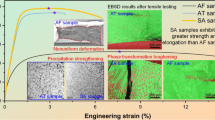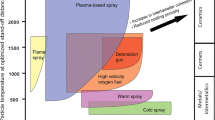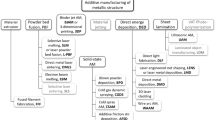Abstract
Thermally sprayed coatings are essentially layered materials and contain large numbers of lamellar pores. It is thus quite necessary to clarify the formation mechanism of lamellar pores which significantly influence coating performances. In the present study, to elaborate the formation mechanism of lamellar pores, the yttria-stabilized zirconia (ZrO2–7 wt% Y2O3, 7YSZ) splats, which have high fracture toughness and tetragonal phase stability, were employed. Interestingly, anomalous epitaxial growth occurred for all deposition temperatures in spite of the extremely high cooling rate, which clearly indicated chemical bonding and complete contact at splat/substrate interface before splat cooling. However, transverse spallation substantially occurred for all deposition temperatures in spite of the high fracture toughness of 7YSZ, which revealed that the lamellar pores were from transverse cracking/spallation due to the large stress during splat cooling. Additionally, fracture mechanics analysis was carried out, and it was found that the stress arose from the constraint effect of the shrinkage of the splat by locally heated substrate with the value about 1.97 GPa. This clearly demonstrated that the stress was indeed large enough to drive transverse cracking/spallation forming lamellar pores during splat cooling. All of these contribute to understanding the essential features of lamellar bonding and further tailoring the coating structures and performance.
Article PDF
Similar content being viewed by others
Avoid common mistakes on your manuscript.
References
Padture NP, Gell M, Jordan EH. Thermal barrier coatings for gas-turbine engine applications. Science 2002, 296: 280–284.
Padture NP. Advanced structural ceramics in aerospace propulsion. Nat Mater 2016, 15: 804–809.
Cao XQ, Vassen R, Stoever D. Ceramic materials for thermal barrier coatings. J Eur Ceram Soc 2004, 24: 1–10.
Zhang WW, Li GR, Zhang Q, et al. Comprehensive damage evaluation of localized spallation of thermal barrier coatings. J Adv Ceram 2017, 6: 230–239.
Soltani R, Heydarzadeh-Sohi M, Ansari M, et al. Effect of APS process parameters on high-temperature wear behavior of nickel–graphite abradable seal coatings. Surf Coat Tech 2017, 321: 403–408.
Sporer DR, Taeck U, Dorfman M, et al. Novel ceramic abradable coatings with enhanced performance. In Proceedings of the ASME Turbo Expo: Power for Land, Sea, and Air, Volume 4: Cycle Innovations; Electric Power; Industrial and Cogeneration; Manufacturing Materials and Metallurgy, 2006: 1017–1023.
Bolelli G, Cannillo V, Lusvarghi L, et al. Wear behaviour of thermally sprayed ceramic oxide coatings. Wear 2006, 261: 1298–1315.
Shipway PH, McCartney DG, Sudaprasert T. Sliding wear behaviour of conventional and nanostructured HVOF sprayed WC–Co coatings. Wear 2005, 259: 820–827.
Hui R, Berghaus JO, Decès-Petit C, et al. High performance metal-supported solid oxide fuel cells fabricated by thermal spray. J Power Sources 2009, 191: 371–376.
Vaβen R, Hathiramani D, Mertens J, et al. Manufacturing of high performance solid oxide fuel cells (SOFCs) with atmospheric plasma spraying (APS). Surf Coat Tech 2007, 202: 499–508.
Chen L, Yang GJ, Li CX, et al. Thermally sprayed ceramic coatings for wear-resistant application and coating structure tailoring towards advanced wear-resistant coatings. Advanced Ceramics 2016, 37: 3–22.(in Chinese)
Ohmori A, Li C-J. Quantitative characterization of the structure of plasma-sprayed Al2O3 coating by using copper electroplating. Thin Solid Films 1991, 201: 241–252.
Rangarajan S, King AH. Non-destructive evaluation of delamination in ceramic thin films on metal substrates by scanning electron microscopy. Thin Solid Films 2001, 385: 22–28.
Chraska T, King AH. Effect of different substrate conditions upon interface with plasma sprayed zirconia—a TEM study. Surf Coat Tech 2002, 157: 238–246.
Chraska T, King AH. Transmission electron microscopy study of rapid solidification of plasma sprayed zirconia—part I. First splat solidification. Thin Solid Films 2001, 397: 30–39.
Chraska T, King AH. Transmission electron microscopy study of rapid solidification of plasma sprayed zirconia—part II. Interfaces and subsequent splat solidification. Thin Solid Films 2001, 397: 40–48.
Li C-J, Ohmori A. Relationships between the microstructure and properties of thermally sprayed deposits. J Therm Spray Tech 2002, 11: 365–374.
Li C-J, Yang G-J, Li C-X. Development of particle interface bonding in thermal spray coatings: A review. J Therm Spray Tech 2013, 22: 192–206.
Dong H, Yang G-J, Cai H-N, et al. Propagation feature of cracks in plasma-sprayed YSZ coatings under gradient thermal cycling. Ceram Int 2015, 41: 3481–3489.
Li C-J, Li Y, Yang G-J, et al. Evolution of lamellar interface cracks during isothermal cyclic test of plasma-sprayed 8YSZ coating with a columnar-structured YSZ interlayer. J Therm Spray Tech 2013, 22: 1374–1382.
Ahmadian S, Jordan EH. Explanation of the effect of rapid cycling on oxidation, rumpling, microcracking and lifetime of air plasma sprayed thermal barrier coatings. Surf Coat Tech 2014, 244: 109–116.
Cheng B, Yang Y-M, Yang N, et al. Sintering-induced delamination of thermal barrier coatings by gradient thermal cyclic test. J Am Ceram Soc 2017, 100: 1820–1830.
Kuroda S, Clyne TW. The quenching stress in thermally sprayed coatings. Thin Solid Films 1991, 200: 49–66.
Kuroda S, Fukushima T, Kitahara S. Significance of quenching stress in the cohesion and adhesion of thermally sprayed coatings. J Therm Spray Tech 1992, 1: 325–332.
Kuroda S, Dendo T, Kitahara S. Quenching stress in plasma sprayed coatings and its correlation with the deposit microstructure. J Therm Spray Tech 1995, 4: 75–84.
Sobolev VV, Guilemany JM, Nutting J, et al. Development of substrate-coating adhesion in thermal spraying. Int Mater Rev 1997, 42: 117–136.
Sobolev VV, Guilemany JM. Droplet-substrate impact interaction in thermal spraying. Mater Lett 1996, 28: 331–335.
Jiang X, Wan Y, Herman H, et al. Role of condensates and adsorbates on substrate surface on fragmentation of impinging molten droplets during thermal spray. Thin Solid Films 2001, 385: 132–141.
McPherson R. The relationship between the mechanism of formation, microstructure and properties of plasma-sprayed coatings. Thin Solid Films 1981, 83: 297–310.
Moreau C, Cielo P, Lamontagne M, et al. Temperature evolution of plasma-sprayed niobium particles impacting on a substrate. Surf Coat Tech 1991, 46: 173–187.
Vardelle M, Vardelle A, Leger AC, et al. Influence of particle parameters at impact on splat formation and solidification in plasma spraying processes. J Therm Spray Tech 1995, 4: 50–58.
Li L, Kharas B, Zhang H, et al. Suppression of crystallization during high velocity impact quenching of alumina droplets: Observations and characterization. Mat Sci Eng A 2007, 456: 35–42.
Kratschmer T, Aneziris CG. Amorphous zones in flame sprayed alumina–titania–zirconia compounds. Ceram Int 2011, 37: 181–188.
Chen L, Yang G-J. Anomalous epitaxial growth in thermally sprayed YSZ and LZ splats. J Therm Spray Tech 2017, 26: 1168–1182.
Chen L, Yang G-J, Li C-X. Formation of lamellar pores for splats via interfacial or sub-interfacial delamination at chemically bonded region. J Therm Spray Tech 2017, 26: 315–326.
Chen L, Yang G-J, Li C-X, et al. Hierarchical formation of intrasplat cracks in thermal spray ceramic coatings. J Therm Spray Tech 2016, 25: 959–970.
Chen L, Yang G-J, Li C-X, et al. Edge effect on crack patterns in thermally sprayed ceramic splats. J Therm Spray Tech 2017, 26: 302–314.
Matejicek J, Sampath S. In situ measurement of residual stresses and elastic moduli in thermal sprayed coatings: Part 1: apparatus and analysis. Acta Mater 2003, 51: 863–872.
Matejicek J, Sampath S, Brand PC, et al. Quenching, thermal and residual stress in plasma sprayed deposits: NiCrAlY and YSZ coatings. Acta Mater 1999, 47: 607–617.
Vassen R, Cao X, Tietz F, et al. Zirconates as new materials for thermal barrier coatings. J Am Ceram Soc 2000, 83: 2023–2028.
Sampath S, Jiang XY, Matejicek J, et al. Substrate temperature effects on splat formation, microstructure development and properties of plasma sprayed coatings Part I: Case study for partially stabilized zirconia. Mat Sci Eng A 1999, 272: 181–188.
Jiang X, Matejicek J, Sampath S. Substrate temperature effects on the splat formation, microstructure development and properties of plasma sprayed coatings Part II: Case study for molybdenum. Mat Sci Eng B 1999, 272: 189–198.
Sampath S, Jiang X. Splat formation and microstructure development during plasma spraying: Deposition temperature effects. Mat Sci Eng A 2001, 304–306: 144–150.
Hao S, Li C-J, Yang G-J. Influence of deposition temperature on the microstructures and properties of plasma-sprayed Al2O3 coatings. J Therm Spray Tech 2011, 20: 160–169.
Zhu X, Mills KL, Peters PR, et al. Fabrication of reconfigurable protein matrices by cracking. Nat Mater 2005, 4: 403–406.
Huh D, Mills KL, Zhu X, et al. Tuneable elastomeric nanochannels for nanofluidic manipulation. Nat Mater 2007, 6: 424–428.
Kim BC, Moraes C, Huang J, et al. Fracture-based fabrication of normally closed, adjustable, and fully reversible microscale fluidic channels. Small 2014, 10: 4020–4029.
Kim BC, Moraes C, Huang J, et al. Fracture-based micro- and nanofabrication for biological applications. Biomater Sci 2014, 2: 288–296.
Chen L, Yang GJ. Imaging the slit pores under the delaminated films by white light interference. J Therm Spray Tech 2018, in press.
Levi CG. Metastability and microstructure evolution in the synthesis of inorganics from precursors. Acta Mater 1998, 46: 787–800.
Pascual C, Durán P. Subsolidus phase equilibia and ordering of the system ZrO2–Y2O3. J Am Ceram Soc 1983, 66: 23–27.
Matejicek J, Sampath S, Gilmore D, et al. In situ measurement of residual stresses and elastic moduli in thermal sprayed coatings: Part 2: Processing effects on properties of Mo coatings. Acta Mater 2003, 51: 873–885.
Matejicek J, Sampath S. Intrinsic residual stresses in single splats produced by thermal spray processes. Acta Mater 2001, 49: 1993–1999.
Suo Z, Hutchinson JW. Steady-state cracking in brittle substrates beneath adherent films. Int J Solids Struct 1989, 25: 1337–1353.
Suo Z, Hutchinson JW. Interface crack between two elastic layers. Int J Fract 1990, 43: 1–18.
Ye T, Suo Z, Evans AG. Thin film cracking and the roles of substrate and interface. Int J Solids Struct 1992, 29: 2639–2648.
Hutchinson JW, Suo Z. Mixed mode cracking in layered materials. Advances in Applied Mechanics 1992, 29: 63–191.
Bagchi A, Evans AG. The mechanics and physics of thin film decohesion and its measurement. Interface Sci 1996, 3: 169–193.
Evans AG, Hutchinson JW. The thermomechanical integrity of thin films and multilayers. Acta Metall Mater 1995, 43: 2507–2530.
Thouless MD, Cao HC, Mataga PA. Delamination from surface cracks in composite materials. J Mater Sci 1989, 24: 1406–1412.
Hutchinson JW. Stresses and failure modes in thin films and multilayers. Lecture Note, 1996. Available at https://www.seas.harvard.edu/hutchinson/papers/462-5.pdf.
Yin HM, Paulino GH, Buttlar WG. An explicit elastic solution for a brittle film with periodic cracks. Int J Fract 2008, 153: 39–52.
Huang R, Prévost JH, Huang ZY, et al. Channel-cracking of thin films with the extended finite element method. Eng Fract Mech 2003, 70: 2513–2526.
Liu XH, Shaw TM, Lane MW, et al. Channel cracking in low-k films on patterned multi-layers. In Proceedings of the IEEE 2004 International Interconnect Technology Conference, 2004: 93–95.
He MY, Hsueh CH, Becher PF. Deflection versus penetration of a wedge-loaded crack: Effects of branch-crack length and penetrated-layer width. Compos Part B-Eng 2000, 31: 299–308.
Zhang Z, Suo Z. Split singularities and the competition between crack penetration and debond at a bimaterial interface. Int J Solids Struct 2007, 44: 4559–4573.
Mei H, Pang Y, Huang R. Influence of interfacial delamination on channel cracking of elastic thin films. Int J Fract 2007, 148: 331–342.
Schmauder S, Meyer M. Correlation between Dundurs’ parameters and elastic constants. Z Metallkd 1992, 83: 524–527.
Beuth JL. Cracking of thin bonded films in residual tension. Int J Solids Struct 1992, 29: 1657–1675.
Krabbe M. Crack mechanisms and crack interaction in thin films. Technical Reports Mechanical Engineering, 2012. Available at https://tidsskrift.dk/me/article/view/21125/18625.
Robertson J, Manning MI. Limits to adherence of oxide scales. Mater Sci Tech 1990, 6: 81–92.
Shenoy VB, Schwartzman AF, Freund LB. Crack patterns in brittle thin films. Int J Fract 2001, 109: 29–45.
Thouless MD. Crack spacing in brittle films on elastic substrates. J Am Ceram Soc 1990, 73: 2144–2146.
Thouless MD, Olsson E, Gupta A. Cracking of brittle films on elastic substrates. Acta Metall Mater 1992, 40: 1287–1292.
Thouless MD, Li Z, Douville NJ, et al. Periodic cracking of films supported on compliant substrates. J Mech Phys Solids 2011, 59: 1927–1937.
Xia ZC, Hutchinson JW. Crack patterns in thin films. J Mech Phys Solids 2000, 48: 1107–1131.
Nahta R, Moran B. Crack spacing in brittle films on dissimilar planar and axisymmetric elastic substrates. Eng Fract Mech 1995, 52: 513–524.
Zhang T-Y, Zhao M-H. Equilibrium depth and spacing of cracks in a tensile residual stressed thin film deposited on a brittle substrate. Eng Fract Mech 2002, 69: 589–596.
Nahta R, Moran B. Film cracking and debonding in a coated fiber. Int J Fract 1996, 79: 351–372.
Bergman TL, Laing AS, Incropera FP, et al. Fundamentals of Heat and Mass Transfer, 7th edn. John Wiley & Sons Inc., 2011.
Acknowledgements
The present project is supported by National Basic Research Program of China (No. 2013CB035701), the Fundamental Research Funds for the Central Universities, and the National Program for Support of Top-notch Young Professionals.
Author information
Authors and Affiliations
Corresponding author
Additional information
This article is published with open access at Springerlink.com
Rights and permissions
Open Access The articles published in this journal are distributed under the terms of the Creative Commons Attribution 4.0 International License (http://creativecommons.org/licenses/by/4.0/), which permits unrestricted use, distribution, and reproduction in any medium, provided you give appropriate credit to the original author(s) and the source, provide a link to the Creative Commons license, and indicate if changes were made.
About this article
Cite this article
Chen, L., Yang, GJ. Epitaxial growth and cracking of highly tough 7YSZ splats by thermal spray technology. J Adv Ceram 7, 17–29 (2018). https://doi.org/10.1007/s40145-017-0252-2
Received:
Revised:
Accepted:
Published:
Issue Date:
DOI: https://doi.org/10.1007/s40145-017-0252-2




